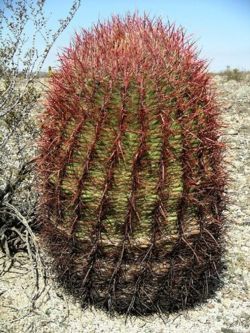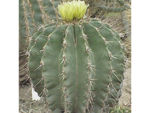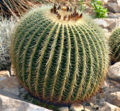Barrel cactus
| Barrel cactus |
|---|

|
| Scientific Classification |
|
| Species |
|
The barrel cactus is located mainly in hot areas of low precipitation. It is known for its barrel-like shape and for the colorful flowers it produces. This particular type of cacti is evergreen, meaning that it doesn't die in the winter. Most of these spiney plants are placed in the genus Ferocactus, the name of which is derived from the Latin word for "fierce". Others have been placed in the genus Echinocactus.[1]
Anatomy
A typical barrel cactus can reach only up to about a meter in height, but there are some that may surpass this height. [2] The Fishhook Barrel cactus, for example, may grow up to as much as 10 meters. [3] The spines which can be seen poking out of these green, ribbed cacti stems vary between species. Some spines may be curved or straight, and the color can be anywhere between yellow and brown. The yellow or red flowers that are located at the very top of their structure do not usually appear until a few years after it first blooms.
Though it is believed by many, the barrel cactus is not full of water. It is, however, filled with a substance called "alkaline juice" which can cause the victim to become very sick if it is drunk.[4]
Reproduction
A Barrel Cactuses primary means of reproduction is sexually by using seeds. The flowers which all of this genera obtains have a structure much like that of any other flower. They have a sepal and petals which are situated above the ovary. When the fertilization is complete, a seed will form in the ovary. This often results in the formation of fruits which emerge from the top. The seed is eventually removed from the cactus and allowed to grow elsewhere. [5]
In comparison to other types of cacti, this particular type of cactus is the latest to come into bloom. [6] Their flowers usually don't open until the warm summer months of low precipitation. [7]
Ecology
As with most other cacti, the barrel cactus is found native to mostly dry desert areas with full sun and low precipitaion. Sometimes this cactus can be found tipped to the side. This is because of its remarkable ability to grow toward the sun, yet toward the south in order to prevent sunburns. [8] They are of great use to certain animals in their habitat because they often provide them with food and shelter. [9]
Genera
There are 2 seperate genus cassifications of these cacti - Ferocactus and Echinocactus.
Though the majority of this species is seperated into the Ferocactus genera, there are some that differ from the usual Barrel cactus and are, therefore, classified into Echinocactus. A Barrel cactus is put into this genera mainly because of differences in appearance, such as larger spines and smaller flowers at the top of its body. There are only 6 types of these cacti which are seperated into the secondary genera. [10]
Gallery
References
- Barrel Cactus Wikipedia
- Barrel Cactus USDA
- Barrel Cactus Genus Ferocactus DestertUSA
- Barrel Cactus Arizona Education
- Echinocactus Wikipedia
- Cactus Britannica




